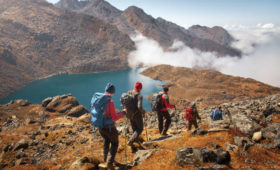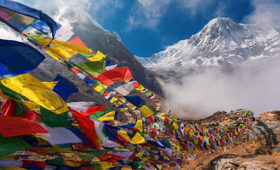The allure of the Himalayas, and more specifically, the Everest region, has captivated adventurers for decades. For many, trekking to Everest Base Camp is a once-in-a-lifetime experience. Let’s explore how to plan the perfect holiday for this extraordinary adventure.
Choosing the Right Time to Trek
Nepal offers diverse weather conditions throughout the year, influencing the best time to embark on your Everest Base Camp trek:
- Spring (March to May): This is the peak trekking season with clear skies, blooming rhododendrons, and comfortable temperatures. However, expect larger crowds and higher prices.
- Autumn (September to November): Similar to spring, autumn offers clear weather and stunning vistas, but with slightly fewer crowds.
- Summer (June to August): While the monsoon season brings lush greenery, it also means rain and potential landslides, making trekking challenging.
- Winter (December to February): This is the off-season with fewer crowds and lower prices, but temperatures are frigid, and some lodges might be closed.
Acclimatization: The Key to Success
Due to the high altitude, acclimatization is crucial to prevent altitude sickness. Plan extra days for rest and gradual ascent. Popular acclimatization stops include Namche Bazaar and Tengboche.
Essential Gear for Your Trek
Packing efficiently is key for a comfortable trek. Essential items include:
- Sturdy hiking boots
- Warm layers, including a down jacket
- Waterproof and windproof gear
- Trekking poles
- Sleeping bag
- Headlamp
- Sunglasses and sunscreen
- Water purification tablets or filter
Choosing the Right Tour Operator
Selecting a reliable tour operator is essential for a smooth trekking experience. Consider the following factors:
- Experience and Reputation: Look for operators with a proven track record and positive reviews.
- Guide Expertise: Experienced guides are crucial for safety and enjoyment.
- Group Size: Smaller groups often offer a more personalized experience.
- Accommodation: Choose between teahouse stays or camping options based on your preference.
- Permits and Logistics: Ensure the operator handles all necessary permits and arrangements.
Trekking Routes and Options
While the Everest Base Camp trek is the most popular, there are other options for those seeking different challenges or experiences:
- Three Passes Trek: This challenging trek offers stunning views and a deeper immersion into Sherpa culture.
- Gokyo Lakes Trek: Known for its pristine lakes and close proximity to Everest, this trek is a beautiful alternative.
- Everest Base Camp with Island Peak Climbing: Combine trekking with a challenging climb for experienced mountaineers.
Beyond the Trek: Exploring Nepal
After conquering Everest Base Camp, take time to explore other parts of Nepal:
- Kathmandu: Immerse yourself in the vibrant culture of Nepal’s capital city.
- Pokhara: Enjoy stunning lake views and explore the Annapurna region.
- Chitwan National Park: Experience the thrill of a jungle safari.
Tips for an Unforgettable Everest Base Camp Trek
- Physical Preparation: Build endurance through hiking and cardio workouts.
- Respect the Environment: Leave no trace and minimize your impact on the fragile mountain ecosystem.
- Cultural Immersion: Interact with local Sherpa people and learn about their culture.
- Capture Memories: Bring a camera to capture the breathtaking scenery.
- Travel Insurance: Ensure you have comprehensive travel insurance covering altitude sickness and emergency evacuation.
Embarking on the Everest Base Camp trek is a life-changing adventure. With careful planning and preparation, you can make the most of this incredible journey.




